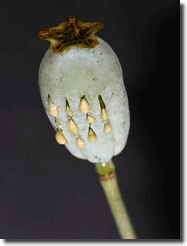
Facts About Heroin
-
 Heroin is a morphine derivative, and morphine is opium’s most potent active ingredient.
Heroin is a morphine derivative, and morphine is opium’s most potent active ingredient.
-
First synthesized in 1874, heroin was widely used in medicine in the early part of the 20th Century, until its addictive potential was recognized.
-
Pure heroin is a white powder with a bitter taste. Street heroin may vary in color from white to dark brown because of impurities or additives. There is a dark brown or black form of the drug, as dense as roofing tar or coal, known as "black tar." Produced in Mexico, it is widely available in the western United States.
-
Heroin in known on the street as 'H', blacktar, brown sugar, dope, horse, junk, mud, skag and most commonly, smack.
-
Heroin is most often snorted or injected, although it may also be smoked.
-
The availability of high-purity heroin in recent years, the spread of HIV infection among intravenous (IV) users, and the negative stereotype of the IV addict prompt many new users to limit themselves to snorting the drug. (some dissolve it in nose drops).
-
Heroin can be mixed with tobacco or marijuana and smoked in a pipe or cigarette. It may also be heated and burned on tinfoil or similar, releasing fumes that users inhale ("chasing the dragon").
-
Injection, in addition to producing a "rush," is an economical route of administration. By injecting the drug, rather than smoking or inhaling it, the same effects are achieved with less heroin. Users who choose this route generally inject directly into a major vein ("mainlining"), although some may start by injecting under the skin ("popping").
-
Heroin produces drowsiness, grogginess, and mental confusion. Characteristic of heroin use is the half-conscious state called "nodding."
-
Heroin abusers often use other drugs as well. They may "speedball," taking cocaine or methamphetamine with heroin, or use alcohol, marijuana, or tranquilizers to enhance the high and blunt effects of withdrawal.
-
In the mid-Nineties, it seemed heroin was suddenly staging a comeback. The reality, however, was that heroin had never left. While overall drug use in the U.S. dropped sharply through the Eighties, heroin use remained relatively steady. During the Nineties, it started to rise, as the addict population grew and changed. Heroin on the street became purer; the price stayed the same; and more young and middle-class Americans began using the drug.
-
Street heroin is rarely pure. A "bag," or single dose, may contain 50 milligrams of powder. In the past, very few of those milligrams were likely to be heroin—most of the bag was filled with such additives as milk sugar, powdered milk, or quinine. In 1980, the average bag was only 4 percent pure heroin. By the mid-Nineties, however, purity was generally 40 percent or higher. In the Northeast, it averaged between 60 and 75 percent.
-
Methadone, a synthetic used mainly as harm reduction treatment of heroin addiction, is often abused and responsible for a number of overdose deaths.

 Heroin is a morphine derivative, and morphine is opium’s most potent active ingredient.
Heroin is a morphine derivative, and morphine is opium’s most potent active ingredient.